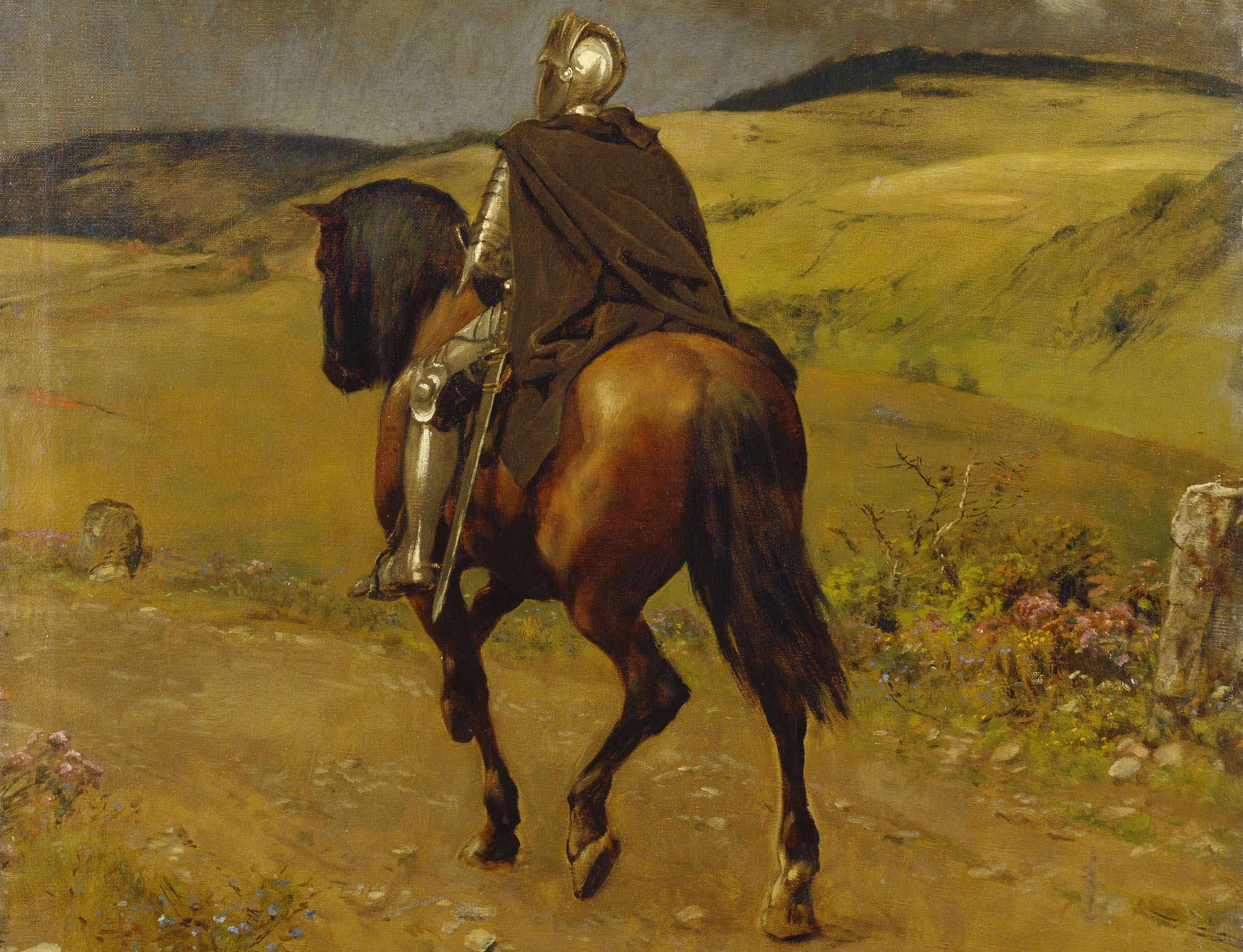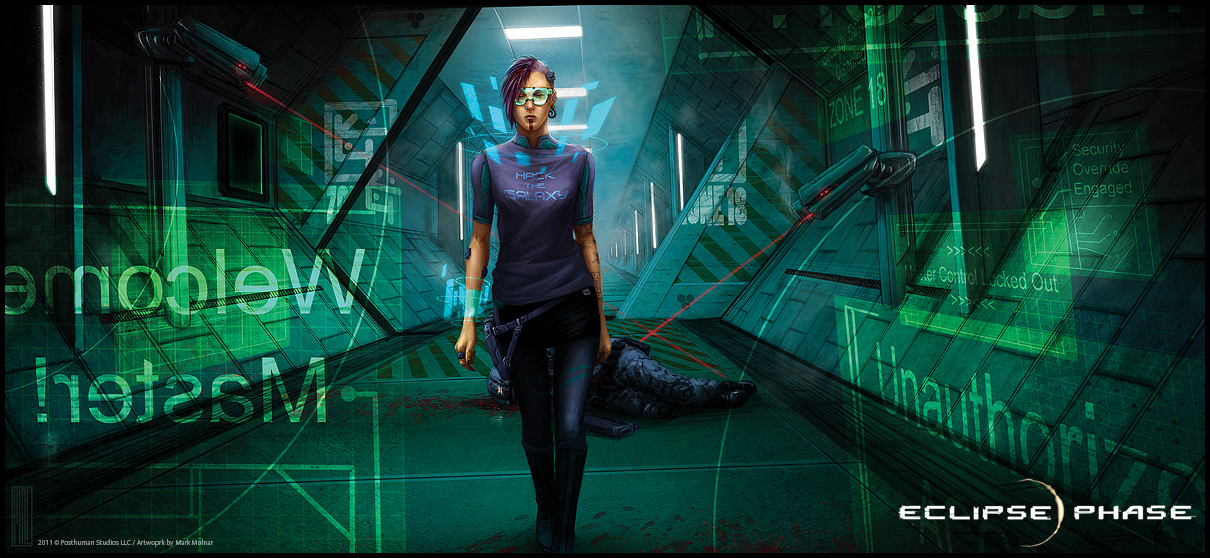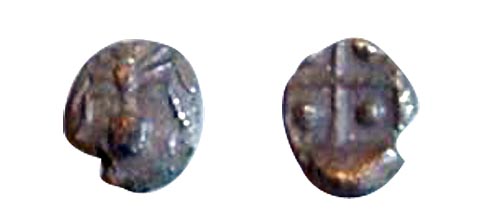
This mini-scenario was originally incorporated into my first 3rd Edition campaign in 2000 or 2001. In 2003, I adapted it as a submission to Atlas Games’ En Route II adventure anthology. Unlike my other submissions, this was one was rejected. I retooled it for Dungeon Magazine in 2004, which also rejected it. In both cases, the objection was to the inclusion of time travel. If you don’t like time travel, the odds are you won’t be a fan, either. Otherwise, I think you’ll enjoy this little taste of the weird.
The following encounter has been designed for four characters of 8th level. Although not a full adventure unto itself, it can be used to add a little spice to an existing adventure or fill a gap when the need arises. It can be incorporated into any journey which takes the PCs along a road.
SUMMARY
While traveling down a road, the PCs have an opportunity to save the Duke of Alasson – also known as the Black Eagle – from worg-riding orcs. An hour later, the PCs have an opportunity to save another Duke of Alasson, this time from wolf-riding ogres. In the process, they discover that they have been at the center of a strange temporal anomaly: The first Duke of Alasson they met lived and died two hundred years before they were born.
THE FIRST EAGLE
The PCs are traveling down a road. Have them make a Listen check (DC 15). If they succeed, read the following to them:
It’s early in the afternoon. The road before you gently rises into a low hill. From beyond the hill, however, you can hear the clear sounds of combat – the clash of sword, the shouts of men, the cries of the wounded.
If the PCs fail their check, tell them that they’re approaching a hill. As they reach the top of the hill – whether they heard the sounds of combat or not – read the following to them:
As you reach the top of the hill, you are met with a scene of fierce and desperate combat below you. More than a dozen squat, swarthy figures astride monstrous wolves have surrounded a group of mounted men in full armor. The men seem to have fallen back some distance from the road now, forming a defensive circle. One man, dressed in black plate with a gold design embossed upon the chest, stands out from the rest – and you easily spot a heraldic banner flying above the group, bearing a golden eagle upon a background of black.
Erren, the third Duke of Alasson is returning from breaking the siege upon Dweredell by the orcish hordes. His army marches several days behind him, but he has galloped ahead after hearing news of an assassination attempt upon his son.
The orcs attacking him seek revenge for his breaking of the siege at Dweredell. Elite leaders within the horde, these orcs saw their army forced into rout and ruin. With their power destroyed or scattered, they gathered and rode in pursuit of the “black eagle of doom” which had broken them.
There are eighteen wolf-riding orcs facing off against the Black Eagle and his eight men. The orcs are fierce fighters and fairly intelligent, but they are not particularly cunning: One group has already charged into combat, and is now engaging in melee. The others are held in reserve. If the PCs make any move to engage the orcs, the nine orcs circling in reserve will charge once at them, and then engage in melee.
THE ORCS OF THE WASTES: Ftr4; CR 4; HD 4d10+11; hp 33; Init +2 (Dex); Spd 30 ft.; AC 17 (+2 Dex, +5 chain shirt); Atk +7 melee (1d8+4/x3, heavy lance) or +6 ranged (1d6/x3, short bow); AL CE; SV Fort +6, Ref +3, Will +0; Str 16, Dex 14, Con 15, Int 10, Wis 8, Cha 8
Skills and Feats: Listen +4, Ride +6, Spot +4; Mounted Combat, Power Attack, Spirited Charge, Toughness
RIDING WARGS: Medium-size Magical Beast; CR 2; HD 4d10+8; hp 30; Init +2 (Dex); Spd 50 ft.; AC 14 (+2 Dex, +2 natural); Atk Bite +7 melee (1d6+4); Face 5 ft. by 5 ft.; Reach 5 ft.; SA Trip; SQ Scent; SV Fort +6, Ref +6, Will +3; Str 17, Dex 15, Con 15, Int 6, Wis 14, Cha 10
Skills: Hide +7, Listen +9, Move Silently +7, Spot +9, Survival +2*
Trip (Ex): A worg that hits with a bite attack can attempt to trip the opponent as a free action without making a touch attack or provking an attack of opportunity. If the attempt fails, the opponent cannot react to the trip of the worg.
Skills: A worg receives a +1 racial bonus to Listen, Move Silently, and Spot checks, and a +2 racial bonus to Hide checks. A worg has a +4 racial bonus to Survival checks when tracking by scent.
AFTER THE FIRST FIGHT
Assuming that the PCs join the fight and help to destroy the orcs, they are approached by the Black Eagle (although the Duke’s men keep a wary eye on the PCs until they have proven themselves trustworthy). The Black Eagle professes, truthfully, that he carries with him no wealth or reward to give in boon to the characters. But he promises that, if the PCs will but ride with him for another three days, then a just reward will be theirs.
If the PCs Continue on Their Way: If the PCs decide to continue on their way, the Black Eagle thanks them again for their heroism – promising that their deeds will be praised in the songs of his halls. He and his retinue then ride out of sight down the road and back into history – the PCs probably never see him again. About an hour later, trigger the encounter with the Second Eagle (below).
If the PCs change their mind and try to catch up with the Black Eagle, they will be unable to find them. PCs who attempt to locate the party’s tracks may make a Survival check at DC 20. On a success, they will be unable to find any tracks but have a certainty that they would have if any existed.
If the PCs Accompany Him: The PCs ride astride with the Black Eagle as part of his entourage for the rest of the day. The Black Eagle will regale them with tales of his deeds (see below) and ask for tales of their deeds, as well. Allow PCs to make a Spot check (DC 25). On a success, let them note that something about the road seems oddly out of place – as if this weren’t quite the same road they had come down. But don’t let them put their thumb on what it is, exactly, that unsettles them.
At dusk, the party makes camp – raising a number of fine tents in an open field. Try to discourage the PCs from keeping a watch (the Black Eagle might take it as an insult if they don’t trust his entourage, for example). If they don’t, then when they awake in the morning they will find the Black Eagle and the entire camp gone without trace. If someone does keep watch, then mid-way through the night they will see the camp fade out of sight and disappear without trace. Either way, when the PCs begin traveling down the road again, trigger the second encounter (see below).
TALES OF THE FIRST EAGLE
The Secret Triumph upon the archery fields of Seranth. The Duke, in defiance of the king’s edict that none of noble blood should compete upon the tourney field in any event save the joust, secretly journeyed to Seranth to participate in the archery contest. There he competed against a man dressed all in black, who was almost his equal with the bow. In the end, the Duke split his own arrow upon the bull’s-eye twice in order to win. His opponent than unmasked, and was revealed to be the king himself.
The Seizing of the Ruby of Westernesse from the Red Prince during the western wars. It was then given as gift to the king, and sits still within the crown.
The Breaking of the Siege of Dweredell. When the dwarven kingdoms fell, the men of Dweredell held siege upon the fallen city of the dwarves for nearly two months before they were forced to fall back. For six weeks the orcs laid siege to Dweredell. In that time, the Duke of Alasson raised a great army and led it to Dweredell – breaking the siege and freeing the city.
THE SECOND EAGLE
Once again have the PCs make a Listen check (DC 15). If they succeed, read the following to them:
About an hour passes before the sound of combat again reaches your ear: Over the next rise it seems as if you hear again the clash of steel, the cry of men, and the bestial howl of the inhuman.
Read the following as the PCs reach the top of the hill:
The scene before you is eerily familiar: A handful of armored men has been surrounded by large, hairy figures astride monstrous wolves. Again, it seems the men have fallen back some distance from the road – forming a defensive circle. Again, you see the distinctive black plate of the Duke of Alasson – and their the banner of the golden eagle upon the black. The figures upon the wolves are larger now – as are the wolves themselves — and it seems that the men fare worse: At least one of their number has already fallen, and you see the signs of bloodying upon several others.
There are eight men accompanying the Duke of Alasson here. They are faced by fifteen Wolf-Riders (see sidebar).
The ogres are far more clever than the orcs of the past: They possess an uncanny advantage with their ability to perform ride-by attacks with reach, and they will not hesitate to make the most of it. Even if the PCs ready an attack against the ogre’s mounted charge, their reach should still allow the ogres to avoid it. Plus, the ogres will have their dire wolves ready an attack after the charge – so if anyone closes with them, the wolves will attack. Combined with the triple damage they do on their attacks, this should make the ogres extremely deadly in melee. The ogres are also smart enough to keep themselves spread out – hemming the duke and his men in, but keeping enough distance between themselves so that area-effect spells are as ineffective as possible.
Five of the ogres will immediately break away from attacking the duke and his men to focus on the PCs. If it becomes clear that the PCs are a credible threat, five more will break off and engage them.
WOLF-RIDERS: Ogre Ftr 2; CR 5; Large Giant; HD 4d8+2d10+12; hp 41; Init –1 (Dex); Spd 30 ft.; AC 19 (-1 size, -1 Dex, +5 natural, +6 +1 chain shirt); Atk +9 melee (2d6+7, huge greatclub) or +9 melee (2d6+7/x3, large heavy lance); Face 5 ft. by 5 ft.; Reach 10 ft. (15-20 ft. with heavy lance); AL LE; SV Fort +9, Ref +0, Will +1; Str 21, Dex 8, Con 15, Int 11, Wis 10, Cha 7
Skills and Feats: Listen +2, Spot +2, Ride +4; Mounted Combat, Ride-By Attack, Spirited Charge
THE RED WOLVES (Dire Wolves): CR3; Large Animal; HD 6d8+18; hp 45; Init +2 (Dex); Spd 50 ft.; AC 19 (-1 size, +2 Dex, +5 chain barding, +3 natural); Atk +10 melee (Bite 1d8+10); Face 5 ft. by 10 ft.; Reach 5 ft.; SA Trip; SQ Scent; SV Fort +8, Ref +7, Will +6; Str 25, Dex 15, Con 17, Int 2, Wis 12, Cha 10
Skills: Hide +5, Listen +6, Move Silently +5, Spot +6, Wilderness Lore +1*
Trip (Ex): A dire wolf that hits with a bite attack can attempt to trip the opponent as a free action without making a touch attack or provking an attack of opportunity. If the attempt fails, the opponent cannot react to the trip of the dire wolf.
Skills: A dire wolf receives a +1 racial bonus to Listen, Move Silently, and Spot checks and a +2 racial bonus to Hide checks. *It also receives a +4 racial bonus to Wilderness Lore checks when tracking by scent.
AFTER THE SECOND FIGHT
As soon as the Black Eagle, Tenth Duke of Alasson, doffs his helm, it should be clear to the PCs that this is a completely different person. Their first thoughts will probably run to impersonation of one sort or another, but if they tell their tale to the Duke his brow will furrow and he will tell them a tale of his ancestor – the third Duke of Alasson – who was beset upon this very road by orcs… and saved by a strange band of heroes. The story was chronicled in the song of the Duke’s life, and is still sung today in his family’s halls today. Marveling at the PCs’ tale, the Duke will ask them to accompany them. If the PCs go with him, he spins for them tales of his ancestor upon the road; treats them to a feast of “long-delayed and newfound honor” in his halls, and rewards them in a fitting manner.
IF THE PCs DON’T SAVE THE EAGLES
If the PCs fail to save the second Duke (the one contemporary with their own time), then the Duke is dead. It’s unfortunate, but no big deal.
If the PCs failed to save the first Duke, however, things change slightly: Now, the second Duke tells a sad tale of the death of his ancestor in a fell ambush by orcs after the breaking of the siege of Dweredell. He still marvels at the PCs’ tale, and invites them to his tent to share stories, food, and drink.
THE BLACK EAGLE AND HIS MEN
These stats can be used for both Black Eagles and their men.
THE BLACK EAGLE: Ftr9; Medium-sized humanoid; CR 9; HD 9d10+18; hp 84; Init +1 (Dex); Spd 30 ft.; AC 26 (+1 Dex, +10 +2 plate, +4 +1 adamantine shield of light fortification, +1 ring of protection +1); Atk +15/+10 melee (1d8+7/17-20, +1 keen longsword), +15/+10 melee (1d8+7/x3, +1 heavy lance), or +10/+5 ranged; SV Fort +8, Ref +4, Will +3; Str 19, Con 14, Dex 12, Int 14, Wis 14, Cha 10
Skills and Feats: Diplomacy +3, Handle Animal +5, Knowledge (etiquette) +5, Knowledge (heraldry) +4, Ride +15, Spot +7; Mounted Combat, Power Attack, Ride-by Attack, Spirited Charge, Trample, Weapon Focus (lance), Weapon Focus (longsword), Weapon Specialization (lance), Weapon Specialization (longsword)
Possessions: +1 keen longsword, +1 heavy lance, +2 plate, +1 adamantine shield of light fortification, ring of protection +1, gauntlets of ogre strength, 2 potions of cure serious wounds, 2 potions of cure moderate wounds,1 potion of endurance, 2 potions of jump
Mount: Light warhorse, half-plate barding (+7 AC)
MEN-AT-ARMS (x5):
Ftr2; Medium-size humanoid; CR 2; HD 2d10+4; hp 21; Init +1 (Dex); Spd 30 ft.; AC 18 (+1 Dex, +5 masterwork breastplate, +2 large steel shield); Atk +6 melee (1d8+2/19-20, masterwork longsword), +5 melee (1d8+2/x3 heavy lance), or +3 ranged; SV Fort +5, Ref +1, Will +0; Str 15, Con 14, Dex 12, Int 14, Wis 10, Cha 10
Skills and Feats: Diplomacy +1, Handle Animal +3, Knowledge (etiquette) +3, Knowledge (heraldry) +3, Ride +6, Spot +3; Mounted Combat, Ride-by Attack, Weapon Focus (longsword)
Possessions: Masterwork longsword, heavy lance, masterwork breastplate, large steel shield
Mount: Light warhorse
CONCLUSION
There is no explanation for what caused the PCs to slip through time: Perhaps it was a sympathetic connection between the plights of the two dukes. Perhaps it was the intercession of some god (known or unknown). Perhaps the PCs didn’t slip through time at all, but instead were visited by spirits of the past (the true heroes of the tale are long dead and forgotten).
The Wolf-Riders faced by the PCs here may be only one small part of a larger organization (possibly consisting of an entire ogre tribe or more). This may mean that there are additional attempts on the Black Eagle’s life that the PCs must help fend off. Or it might mean that the PCs have earned the enmity of dangerous giants.
The PCs also have a chance here to forge a friendship with the current Duke of Alasson.
The Black Eagles of Alasson have a long history of greatness, with a single exception: The Fifth Duke, it is said, went mad and disappeared into the west – taking with him the ancestral sword of the house. Perhaps it is time for someone to uncover the sword’s resting place and return it to the Duke.



















